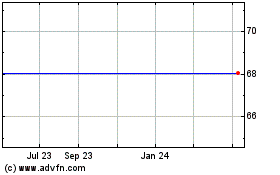U.S. Shale Driller Whiting Petroleum Files For Bankruptcy -- Update
April 01 2020 - 6:08PM
Dow Jones News
By Collin Eaton and Andrew Scurria
U.S. shale driller Whiting Petroleum Corp. filed for bankruptcy
protection on Wednesday, becoming the first sizable fracking
company to succumb to the crash in oil prices.
Whiting's bankruptcy filing comes as many U.S. oil drillers face
pressure to meet hefty debt obligations they took out from banks
and bondholders to make America into the world's largest oil and
gas producer, as U.S. benchmark crude prices drop to their lowest
levels in nearly two decades.
Oil prices are coming off their largest monthly drop ever as the
coronavirus pandemic saps oil demand at the same time Saudi Arabia
presses a price war against Russia by flooding global markets with
crude. The price deterioration has pushed many U.S. shale companies
to the brink of bankruptcy and upended efforts by those already in
chapter 11 to restructure their operations.
If the downturn persists, a number of U.S. drillers could
default on more than $32 billion of high-yield debt over this year,
with a projected default rate of 17%, according to credit-ratings
firm Fitch Ratings. Before crude tanked, Fitch had forecast a 7%
default rate for 2020.
Last year, 41 U.S. oil companies filed for bankruptcy protection
in cases involving $11.7 billion in debt, according to Dallas law
firm Haynes & Boone.
With U.S. crude trading at around $20 a barrel -- down from
above $60 a barrel in January -- dozens of U.S. shale producers are
at risk of breaching debt covenants as their ratios of debt to
pretax earnings balloon to untenable levels. To make matters worse,
equity and debt markets that recapitalized producers in the last
downturn a few years ago have largely closed to U.S. oil companies
after years of poor returns, said Shawn Reynolds, portfolio manager
at investment manager VanEck.
"There's hardly anything you can do," outside of restructuring
debt, Mr. Reynolds said.
Whiting sought chapter 11 protection in U.S. Bankruptcy Court in
Houston, after some bondholders agreed to swap $2.2 billion in debt
for a 97% equity stake in the reorganized company.
Whiting said it needed to file for bankruptcy in part over
worries that the company's borrowing capacity on a $1 billion loan
would be cut.
In court on Wednesday, Whiting lawyer Brian Schartz said the
company thought the borrowing base wouldn't go "anywhere but down."
He said the company was still rounding up the required support from
creditors for the debt-for-equity swap.
Bankruptcies in the U.S. oil patch are expected to gain momentum
in the second quarter, accelerating as some drillers are forced to
shut in production amid reduced oil demand and low available
storage capacity, said Buddy Clark, a partner and co-chair of
energy practice group at Haynes & Boone.
"It's a dire situation for everyone," Mr. Clark said, noting
that even bankruptcy courts are struggling to operate amid the
pandemic and are under pressure from an influx of new cases. "It's
a weird dynamic, but people will want to get into bankruptcy
quickly in order to beat the rush."
A number of oil-and-gas companies, including Chesapeake Energy
Corp., Ultra Petroleum Corp. and California Resources Corp., have
either warned they may not stay current on their debts or hired
restructuring advisers to negotiate with creditors.
Denver-based Whiting, one of the largest drillers in North
Dakota's Bakken Shale, had come under financial pressure even
before U.S. crude prices collapsed.
Chief Executive Brad Holly said the company's proposed
restructuring was its "best path forward" given uncertainty about
how long the Saudi-Russia price war and the coronavirus pandemic
would go on.
Whiting foreshadowed its bankruptcy by taking steps on Friday to
protect $3.4 billion in net operating losses, which are potentially
valuable tax assets that could be used to reduce future federal
taxes.
The company also drew down $650 million from its loan facility
last week to generate cash and won't make a $262 million debt
payment that comes due Wednesday. The maturing bond has lost more
than 90% of its value since mid-February, according to MarketAxess,
and closed at 6 cents on the dollar on Wednesday.
Before the bankruptcy, Whiting's top five executives got board
approval for $14.5 million in cash payments last week, including
$6.4 million for Mr. Holly, according to a regulatory filing. The
executives would be required to waive their participation in a
previous bonus program and forfeit equity awards granted earlier
this year.
Under Whiting's restructuring proposal, top executives are in
line to receive up to 8% of the stock in the reorganized company
when it emerges from bankruptcy. Mr. Holly and other insiders
together own less than 1% of the company, according to data from
FactSet.
Write to Andrew Scurria at Andrew.Scurria@wsj.com
(END) Dow Jones Newswires
April 01, 2020 17:53 ET (21:53 GMT)
Copyright (c) 2020 Dow Jones & Company, Inc.
Whiting Petroleum (NYSE:WLL)
Historical Stock Chart
From Mar 2024 to Apr 2024

Whiting Petroleum (NYSE:WLL)
Historical Stock Chart
From Apr 2023 to Apr 2024
